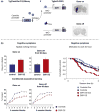Modeling cognitive endophenotypes of schizophrenia in mice
- PMID: 19409625
- PMCID: PMC4928481
- DOI: 10.1016/j.tins.2009.02.003
Modeling cognitive endophenotypes of schizophrenia in mice
Abstract
Schizophrenia is a complex mental disorder that is still characterized by its symptoms rather than by biological markers because we have only a limited knowledge of its underlying molecular basis. In the past two decades, however, technical advances in genetics and brain imaging have provided new insights into the biology of the disease. Based on these advances we are now in a position to develop animal models that can be used to test specific hypotheses of the disease and explore mechanisms of pathogenesis. Here, we consider some of the insights that have emerged from studying in mice the relationship between defined genetic and molecular alterations and the cognitive endophenotypes of schizophrenia.
Figures



Similar articles
-
The dopamine hypothesis of schizophrenia: version III--the final common pathway.Schizophr Bull. 2009 May;35(3):549-62. doi: 10.1093/schbul/sbp006. Epub 2009 Mar 26. Schizophr Bull. 2009. PMID: 19325164 Free PMC article. Review.
-
Insights About Striatal Circuit Function and Schizophrenia From a Mouse Model of Dopamine D2 Receptor Upregulation.Biol Psychiatry. 2017 Jan 1;81(1):21-30. doi: 10.1016/j.biopsych.2016.07.004. Epub 2016 Jul 14. Biol Psychiatry. 2017. PMID: 27720388 Free PMC article. Review.
-
A possible role for the striatum in the pathogenesis of the cognitive symptoms of schizophrenia.Neuron. 2010 Mar 11;65(5):585-96. doi: 10.1016/j.neuron.2010.02.014. Neuron. 2010. PMID: 20223196 Free PMC article. Review.
-
Dopamine hypothesis of schizophrenia: making sense of it all.Curr Psychiatry Rep. 2007 Aug;9(4):329-36. doi: 10.1007/s11920-007-0041-7. Curr Psychiatry Rep. 2007. PMID: 17880866 Review.
-
Modeling excess striatal D2 receptors in mice.Prog Brain Res. 2009;179:59-65. doi: 10.1016/S0079-6123(09)17907-4. Epub 2009 Nov 20. Prog Brain Res. 2009. PMID: 20302818 Review.
Cited by
-
Preclinical models of antipsychotic drug action.Int J Neuropsychopharmacol. 2013 Nov;16(10):2131-44. doi: 10.1017/S1461145713000606. Epub 2013 Jun 10. Int J Neuropsychopharmacol. 2013. PMID: 23745738 Free PMC article. Review.
-
Latrophilins: A Neuro-Centric View of an Evolutionary Conserved Adhesion G Protein-Coupled Receptor Subfamily.Front Neurosci. 2019 Jul 9;13:700. doi: 10.3389/fnins.2019.00700. eCollection 2019. Front Neurosci. 2019. PMID: 31354411 Free PMC article.
-
Operant Assessment of DMTP Spatial Working Memory in Mice.Front Behav Neurosci. 2019 Aug 27;13:193. doi: 10.3389/fnbeh.2019.00193. eCollection 2019. Front Behav Neurosci. 2019. PMID: 31507388 Free PMC article.
-
Modeling motivational deficits in mouse models of schizophrenia: behavior analysis as a guide for neuroscience.Behav Processes. 2011 May;87(1):149-56. doi: 10.1016/j.beproc.2011.02.004. Epub 2011 Feb 18. Behav Processes. 2011. PMID: 21338658 Free PMC article. Review.
-
Hippocampal Hyperactivity as a Druggable Circuit-Level Origin of Aberrant Salience in Schizophrenia.Front Pharmacol. 2020 Oct 16;11:486811. doi: 10.3389/fphar.2020.486811. eCollection 2020. Front Pharmacol. 2020. PMID: 33178010 Free PMC article. Review.
References
-
- Burmeister M, et al. Psychiatric genetics: progress amid controversy. Nat Rev Genet. 2008;9:527–540. - PubMed
-
- Allen NC, et al. Systematic meta-analyses and field synopsis of genetic association studies in schizophrenia: the SzGene database. Nat Genet. 2008;40:827–834. - PubMed
-
- Walsh T, et al. Rare structural variants disrupt multiple genes in neurodevelopmental pathways in schizophrenia. Science. 2008;320:539–543. - PubMed
Publication types
MeSH terms
Substances
Grants and funding
LinkOut - more resources
Full Text Sources
Other Literature Sources
Medical
Miscellaneous

